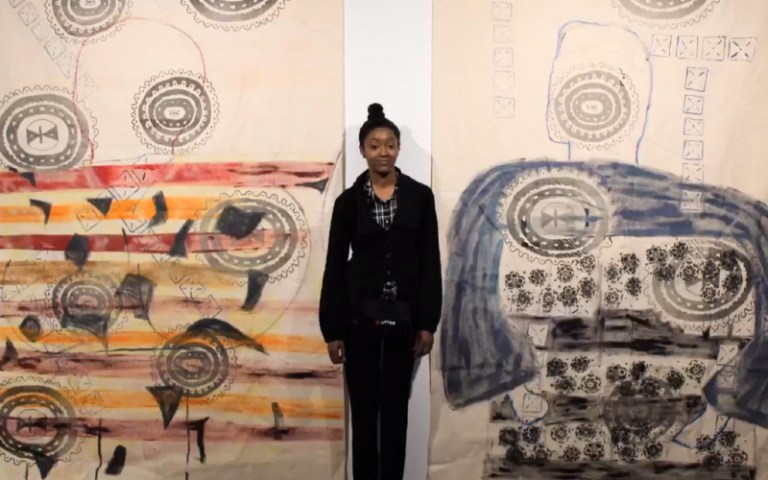Q&A: Meet Abi Ola, student artist in residence
27 September 2021
Abi Ola, one of the two 2021 UCL East student artists in residence, shares an insight into her inspirations, art practice and the work she is developing on the residency.

For the past few months, two UCL student artists in residence, Abi Ola and Yifan He, have been working with the UCL East Project team, to observe, comment and creatively reflect upon this significant development for UCL.
The residencies are supported by the UCL East Programme and are Part of the UCL Public Art Programme, these residencies are one of the ways that UCL East supports future generations of artists, through providing opportunities and exposure.
Here Abi shares an insight into her inspirations, practice and the work she is developing on the residency.
How would you describe your practice?
Patterns play a significant role in my practice. I collect a variety of shapes from different sources such as tribal art, African and Oceanic textiles, gallery trips to the British and V&A Museums, William Morris wallpaper designs, and old family clothing.
These patterns and their history represent my heritage being West African and living in the UK. It also symbolises my family through using old clothes and fabrics.
I paint faceless family portraits to hide their identity, to show that I do not know these people very well, and to allow the audience to place themselves or their loved ones within my faceless paintings.
Do you have some ideas/outcomes from the residency so far?
Ultimately, I want to make a patterned wallpaper to install inside one of the cafes of the UCL East campus, or in a corridor, so that passers-by can see my art.
On top of this I would have a QR code next to the installation so that passers-by can scan it onto their smartphones and interact with my 3D patterned painting environments.
How has the UCL East development influenced your thinking and what have you learnt so far?
Recently, I visited the African and Oceanic textiles collection at UCL's Department of Anthropology . Viewing all these fabrics was very inspirational. I learnt how to identify certain fabrics to their country of origin, such as geometric shapes being associated with Figi, and indigo with Nigeria.
Now I am more confident to ask different departments for help with my research, and I am beginning to look at my art from an anthropological perspective.
How much have you engaged with the local communities so far in your residency?
The local community is integral to my interactive installation ideas. Currently, my idea is to use QR codes for the local community to scan and interact with my 3D paintings, so that people not necessarily interested in art can be exposed to it.
Furthermore, if the coronavirus restrictions continue to decrease, I want to make reliefs so that the deaf and blind can also interact with my patterns. This would be placed on a board outside of the UCL East buildings or besides my wallpapers.
What are some key lessons you have learnt so far in your residency?
Working independently has given me an insight into how I can develop large projects on my own. At first the idea of making public art was daunting, but now it is easier to get my head around.
Moreover, being introduced to the different departments, such as anthropology, culture lab, and architecture has made me see how easy it is to contact and work with them.
Lastly, how do you think your experience on the residency will inform your future practice?
Thanks to the experience of doing this residency, I now want to collaborate more with anthropology, and the culture lab.
My interest in engaging the public has also deepened, and I now want to think about people who cannot experience art visually due to a disability, and how I can involve them too.
Explore the work of the other student in residence, Yifan Han, here
 Close
Close

